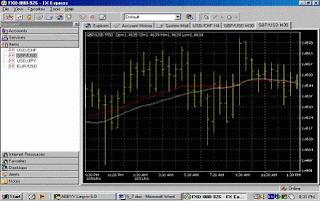 |
| Figure 5.41. An example of MACD |
Momentum is an oscillator designed to measure the rate of price change, not the actual price level. This oscillator consists of the net difference between the current closing price and the oldest closing price from a predetermined period.
The formula for calculating the momentum (M) is:
M=CCP-OCP, where
CCP - current closing price
OCP - old closing price for the predetermined period.
 |
| Figure 5.42. An example of the momentum oscillator |
The Relative Strength Index (RSI)
The relative strength index is a popular oscillator devised by Welles Wilder. The RSI measures the relative changes between the higher and lower closing prices. (See Figure 5.43.)
 |
| Figure 5.43. An example of the RSI oscillator |
Л5/=100-[100/(1+RS)], where
RS - (average of X days up closes/average of X days down
closes);
X - predetermined number of days The original number of
days, as used by its author, was 14 days. Currently, a 9-day
period is more popular.
The rate of change is another version of the momentum oscillator. The difference consists in the fact that, while the momentum's formula is based on subtracting the oldest closing price from the most recent, the ROC's formula is based on dividing the oldest closing price into the most recent one. (See Figure 5.44.)
 |
| Figure 5.44. An example of the rate of change (ROC) oscillator |
ROC = (CCP/OCP) * 100, where
CCP - current closing price;
OCP = old closing price for the predetermined period Larry
Williams %R.
The Larry Williams %R is a version of the stochastics oscillator. It consists of the difference between the high price of a predetermined number of days and the current closing price, which difference in turn is divided by the total range. This oscillator is plotted on a reversed 0 to 100 scale. Therefore, the bullish reversal signals occur at under 80 percent, and the bearish signals appear at above 20 percent. The interpretations are similar to those discussed under stochastics. (See Figure 5.45.)
Commodity Channel Index (CCI)
The commodity channel index was developed by Donald Lambert. It consists of the difference between the mean price of the currency and the average of the mean price over a predetermined period of time (See Figure 5.46.). A buying signal is generated when the price exceeds the upper (+100) line, and a selling signal occurs when the price dips under the lower (-100) line. (See Figure 5.46.)
 |
| Figure 5.45. An example of the Larry Williams %R oscillator |
 |
| Figure 5.46. An example of the commodity channel index |
The Bollinger bands combine a moving average with the instrument's volatility. The bands were designed to gauge whether prices are high or low on a relative basis via volatility. The two are plotted two standard deviations above and below a 20-day simple moving average.
The bands look a lot like an expanding and contracting envelope model. When the band contracts drastically, the signal is that volatility is low and thus likely to expand in the near future. An additional signal is a succession of two top formations, one outside the band followed by one inside. If it occurs above the band, it is a selling signal. When it occurs below the band, it is a buying signal. (See Figure 5.47.)
The Parabolic System (SAR)
The parabolic system is a stop-loss system based on price and time.The system was devised to supplement the inadvertent gaps of the other trend-following systems. The name of the system is derived from its parabolic shape, which follows the price gyrations. It is represented by a dotted line. When the parabola is placed under the price, it suggests a long position. Conversely, when placed above the price, the parabola indicates a short position. (See Figure 5.48.) The parabolic system can be used with oscillators. SAR stands for stop and reverse. The stop moves daily in the direction of the new trend. The built-in acceleration factor pushes the SAR to catch up with the currency price. If the new trend fails, the SAR signal will be generated.
The Directional Movement Index (DMI)
The directional movement index provides a signal of trend presence in the market. The line simply rates the price directional movement on a scale of0 to 100. The higher the number, the better the trend potential of a movement, and vice versa. (See Figure 5.49.) This system can be used by itself or as a filter to the SAR system.
Traders use different combinations of technical tools in their daily trading and analysis. Some of the more popular oscillators are shown in Figure 5.50.
 |
| Figure 5.47. A market example of Bollinger bands |
 |
| Figure 5.48. An example of the SAR parabolic study |
 |
| Figure 5.49. Example of the directional movement index (DMI) |
 |
| Figure 5.50. Example of oscillator combinations used for trading |
















